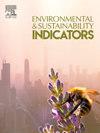区域绿色发展力量:概念解构与动态测量
IF 5.4
Q1 ENVIRONMENTAL SCIENCES
引用次数: 0
摘要
绿色发展力量(GDF)代表了特定区域内各种实体实现经济和社会效益最大化,同时最大限度地减少资源和环境压力的发展的集体潜力。它是实现绿色发展的重要保障。本研究建立了一个涵盖经济、社会、资源和环境四个关键领域的综合评价框架。利用2010年至2021年中国30个省份的数据,研究了GDF的区域差异演变,并确定了GDF系统中的主要障碍。采用综合指数方法,我们将各省分为四类——“强主动”、“弱主动”、“弱被动”和“强被动”——以准确识别每一类中的弱点。这些发现揭示了几个重要的方面:在观察期间,中国各省的GDF表现出不同程度的进步,东部地区的GDF提高,西部地区的GDF落后,两者之间存在显著差异。GDF的区域差距逐渐扩大,在北部沿海、东部沿海和大西南地区出现两极分化。最后,阻碍gdp增长的主要障碍在于资源节约、高效利用和环境治理。这些挑战是弱势群体共同面临的。强主动类别必须优先考虑资源和环境承载能力,而强被动类别应侧重于加强公共服务提供和资源可持续性。本研究对加强GDF、促进区域绿色同步发展具有重要参考价值。本文章由计算机程序翻译,如有差异,请以英文原文为准。
Regional green development force: Conceptual deconstruction and dynamic measurement
The Green Development Force (GDF) represents the collective potency of various entities within a given region to attain development that maximizes economic and social benefits while minimizing the strain on resources and the environment. It serves as a vital guarantee for the realization of green development. This study has established a comprehensive evaluation framework for GDF, encompassing four pivotal domains: economy, society, resources, and environment. By utilizing data spanning from 2010 to 2021, gathered from 30 provinces in China, we examine the evolution of regional disparities in GDF and identify the primary impediments within the GDF system. Employing a comprehensive index approach, we classify the provinces into four categories — “strong-active,” “weak-active,” “weak-passive,” and “strong-passive” — to accurately identify the weaknesses within each group. The findings shed light on several significant aspects: GDF within Chinese provinces has displayed varying degrees of progress over the observation period, with a notable discrepancy between the East, marked by heightened GDF, and the West, where it lags. The regional gaps in GDF have gradually widened, and polarization has emerged in the Northern coastal, Eastern coastal, and Great Southwestern regions. Lastly, the primary obstacles hindering the augmentation of GDF lie in the realm of resource conservation, efficient utilization, and environmental governance. These challenges are shared among the weaker groups. The strong-active category must prioritize resource and environmental carrying capacities, while the strong-passive group should focus on bolstering public service provision and resource sustainability. This study serves as a valuable reference in fortifying GDF and fostering synchronized green development throughout the region.
求助全文
通过发布文献求助,成功后即可免费获取论文全文。
去求助
来源期刊

Environmental and Sustainability Indicators
Environmental Science-Environmental Science (miscellaneous)
CiteScore
7.80
自引率
2.30%
发文量
49
审稿时长
57 days
 求助内容:
求助内容: 应助结果提醒方式:
应助结果提醒方式:


